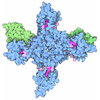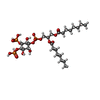+ Open data
Open data
- Basic information
Basic information
| Entry | Database: PDB / ID: 9ixy | |||||||||||||||||||||
|---|---|---|---|---|---|---|---|---|---|---|---|---|---|---|---|---|---|---|---|---|---|---|
| Title | Human KCNQ2-CaM-Ebio2 Complex in the Presence of PIP2 | |||||||||||||||||||||
 Components Components |
| |||||||||||||||||||||
 Keywords Keywords | MEMBRANE PROTEIN / voltage-gated potassium channel | |||||||||||||||||||||
| Function / homology |  Function and homology information Function and homology informationtransporter inhibitor activity / axon initial segment / Voltage gated Potassium channels / establishment of protein localization to mitochondrial membrane / type 3 metabotropic glutamate receptor binding / node of Ranvier / voltage-gated monoatomic cation channel activity / Interaction between L1 and Ankyrins / ankyrin binding / response to corticosterone ...transporter inhibitor activity / axon initial segment / Voltage gated Potassium channels / establishment of protein localization to mitochondrial membrane / type 3 metabotropic glutamate receptor binding / node of Ranvier / voltage-gated monoatomic cation channel activity / Interaction between L1 and Ankyrins / ankyrin binding / response to corticosterone / negative regulation of high voltage-gated calcium channel activity / negative regulation of calcium ion export across plasma membrane / regulation of cardiac muscle cell action potential / presynaptic endocytosis / nitric-oxide synthase binding / regulation of synaptic vesicle exocytosis / regulation of cell communication by electrical coupling involved in cardiac conduction / calcineurin-mediated signaling / adenylate cyclase binding / action potential / protein phosphatase activator activity / voltage-gated potassium channel activity / catalytic complex / detection of calcium ion / regulation of synaptic vesicle endocytosis / regulation of cardiac muscle contraction / postsynaptic cytosol / regulation of cardiac muscle contraction by regulation of the release of sequestered calcium ion / phosphatidylinositol 3-kinase binding / presynaptic cytosol / regulation of release of sequestered calcium ion into cytosol by sarcoplasmic reticulum / titin binding / sperm midpiece / regulation of calcium-mediated signaling / voltage-gated potassium channel complex / potassium ion transmembrane transport / calcium channel complex / substantia nigra development / regulation of heart rate / calyx of Held / response to amphetamine / adenylate cyclase activator activity / sarcomere / nitric-oxide synthase regulator activity / protein serine/threonine kinase activator activity / regulation of cytokinesis / spindle microtubule / calcium channel regulator activity / response to calcium ion / mitochondrial membrane / G2/M transition of mitotic cell cycle / Schaffer collateral - CA1 synapse / long-term synaptic potentiation / spindle pole / calcium-dependent protein binding / synaptic vesicle membrane / nervous system development / myelin sheath / growth cone / chemical synaptic transmission / vesicle / transmembrane transporter binding / calmodulin binding / G protein-coupled receptor signaling pathway / protein domain specific binding / calcium ion binding / synapse / centrosome / protein kinase binding / protein-containing complex / nucleus / membrane / plasma membrane / cytoplasm Similarity search - Function | |||||||||||||||||||||
| Biological species |  Homo sapiens (human) Homo sapiens (human) | |||||||||||||||||||||
| Method | ELECTRON MICROSCOPY / single particle reconstruction / cryo EM / Resolution: 3.1 Å | |||||||||||||||||||||
 Authors Authors | Yang, Z. / Guo, J. | |||||||||||||||||||||
| Funding support |  China, 1items China, 1items
| |||||||||||||||||||||
 Citation Citation |  Journal: Nat Chem Biol / Year: 2025 Journal: Nat Chem Biol / Year: 2025Title: Small molecule inhibits KCNQ channels with a non-blocking mechanism. Authors: Junnan Li / Zhenni Yang / Shaoying Zhang / Yangliang Ye / Jiangnan He / Yan Zhang / Huayun Han / Wan Kong / Jiangru Liu / Yu Min / Juwen Shen / Lianghe Mei / Zongsheng Chen / Panpan Hou / ...Authors: Junnan Li / Zhenni Yang / Shaoying Zhang / Yangliang Ye / Jiangnan He / Yan Zhang / Huayun Han / Wan Kong / Jiangru Liu / Yu Min / Juwen Shen / Lianghe Mei / Zongsheng Chen / Panpan Hou / Jiangtao Guo / Qiansen Zhang / Huaiyu Yang /  Abstract: Voltage-gated ion channels (VGICs) are crucial targets for neuropsychiatric therapeutics owing to their role in controlling neuronal excitability and the established link between their dysfunction ...Voltage-gated ion channels (VGICs) are crucial targets for neuropsychiatric therapeutics owing to their role in controlling neuronal excitability and the established link between their dysfunction and neurological diseases, highlighting the importance of identifying modulators with distinct mechanisms. Here we report two small-molecule modulators with the same chemical scaffold, Ebio2 and Ebio3, targeting a potassium channel KCNQ2, with opposite effects: Ebio2 acts as a potent activator, whereas Ebio3 serves as a potent and selective inhibitor. Guided by cryogenic electron microscopy, patch-clamp recordings and molecular dynamics simulations, we reveal that Ebio3 attaches to the outside of the inner gate, employing a unique non-blocking inhibitory mechanism that directly squeezes the S6 pore helix to inactivate the KCNQ2 channel. Ebio3 also showed efficacy in inhibiting currents of KCNQ2 pathogenic gain-of-function mutations, presenting an avenue for VGIC-targeted therapies. Overall, these findings contribute to the understanding of KCNQ2 inhibition and provide insights into developing selective, non-blocking VGIC inhibitors. | |||||||||||||||||||||
| History |
|
- Structure visualization
Structure visualization
| Structure viewer | Molecule:  Molmil Molmil Jmol/JSmol Jmol/JSmol |
|---|
- Downloads & links
Downloads & links
- Download
Download
| PDBx/mmCIF format |  9ixy.cif.gz 9ixy.cif.gz | 761.1 KB | Display |  PDBx/mmCIF format PDBx/mmCIF format |
|---|---|---|---|---|
| PDB format |  pdb9ixy.ent.gz pdb9ixy.ent.gz | Display |  PDB format PDB format | |
| PDBx/mmJSON format |  9ixy.json.gz 9ixy.json.gz | Tree view |  PDBx/mmJSON format PDBx/mmJSON format | |
| Others |  Other downloads Other downloads |
-Validation report
| Summary document |  9ixy_validation.pdf.gz 9ixy_validation.pdf.gz | 1.6 MB | Display |  wwPDB validaton report wwPDB validaton report |
|---|---|---|---|---|
| Full document |  9ixy_full_validation.pdf.gz 9ixy_full_validation.pdf.gz | 1.7 MB | Display | |
| Data in XML |  9ixy_validation.xml.gz 9ixy_validation.xml.gz | 65.7 KB | Display | |
| Data in CIF |  9ixy_validation.cif.gz 9ixy_validation.cif.gz | 88.6 KB | Display | |
| Arichive directory |  https://data.pdbj.org/pub/pdb/validation_reports/ix/9ixy https://data.pdbj.org/pub/pdb/validation_reports/ix/9ixy ftp://data.pdbj.org/pub/pdb/validation_reports/ix/9ixy ftp://data.pdbj.org/pub/pdb/validation_reports/ix/9ixy | HTTPS FTP |
-Related structure data
| Related structure data |  60981MC  9ixzC M: map data used to model this data C: citing same article ( |
|---|---|
| Similar structure data | Similarity search - Function & homology  F&H Search F&H Search |
- Links
Links
- Assembly
Assembly
| Deposited unit | 
|
|---|---|
| 1 |
|
- Components
Components
| #1: Protein | Mass: 70880.742 Da / Num. of mol.: 4 Source method: isolated from a genetically manipulated source Source: (gene. exp.)  Homo sapiens (human) / Gene: KCNQ2 / Cell line (production host): HEK293 / Production host: Homo sapiens (human) / Gene: KCNQ2 / Cell line (production host): HEK293 / Production host:  Homo sapiens (human) / References: UniProt: O43526 Homo sapiens (human) / References: UniProt: O43526#2: Protein | Mass: 19615.445 Da / Num. of mol.: 4 Source method: isolated from a genetically manipulated source Source: (gene. exp.)  Homo sapiens (human) / Gene: CALM3, CALML2, CAM3, CAMC, CAMIII / Cell line (production host): HEK293 / Production host: Homo sapiens (human) / Gene: CALM3, CALML2, CAM3, CAMC, CAMIII / Cell line (production host): HEK293 / Production host:  Homo sapiens (human) / References: UniProt: P0DP25 Homo sapiens (human) / References: UniProt: P0DP25#3: Chemical | ChemComp-A1L3C / ~{ Mass: 335.348 Da / Num. of mol.: 4 / Source method: obtained synthetically / Formula: C17H19F2N3O2 / Feature type: SUBJECT OF INVESTIGATION #4: Chemical | ChemComp-PIO / [( Has ligand of interest | Y | Has protein modification | N | |
|---|
-Experimental details
-Experiment
| Experiment | Method: ELECTRON MICROSCOPY |
|---|---|
| EM experiment | Aggregation state: PARTICLE / 3D reconstruction method: single particle reconstruction |
- Sample preparation
Sample preparation
| Component | Name: KCNQ2-Ebio2 / Type: COMPLEX / Entity ID: #1-#2 / Source: RECOMBINANT |
|---|---|
| Source (natural) | Organism:  Homo sapiens (human) Homo sapiens (human) |
| Source (recombinant) | Organism:  Homo sapiens (human) / Cell: hek 293 Homo sapiens (human) / Cell: hek 293 |
| Buffer solution | pH: 8 |
| Specimen | Embedding applied: NO / Shadowing applied: NO / Staining applied: NO / Vitrification applied: YES |
| Vitrification | Cryogen name: ETHANE |
- Electron microscopy imaging
Electron microscopy imaging
| Experimental equipment |  Model: Titan Krios / Image courtesy: FEI Company |
|---|---|
| Microscopy | Model: TFS KRIOS |
| Electron gun | Electron source:  FIELD EMISSION GUN / Accelerating voltage: 300 kV / Illumination mode: FLOOD BEAM FIELD EMISSION GUN / Accelerating voltage: 300 kV / Illumination mode: FLOOD BEAM |
| Electron lens | Mode: BRIGHT FIELD / Nominal defocus max: 1600 nm / Nominal defocus min: 800 nm / Cs: 2.7 mm |
| Image recording | Electron dose: 52 e/Å2 / Film or detector model: GATAN K2 QUANTUM (4k x 4k) |
- Processing
Processing
| CTF correction | Type: PHASE FLIPPING AND AMPLITUDE CORRECTION |
|---|---|
| 3D reconstruction | Resolution: 3.1 Å / Resolution method: FSC 0.143 CUT-OFF / Num. of particles: 74947 / Symmetry type: POINT |
 Movie
Movie Controller
Controller




 PDBj
PDBj


